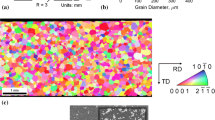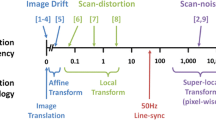Abstract
A combination of drift distortion removal and spatial distortion removal are performed to correct Scanning Electron Microscope (SEM) images at both ×200 and ×10,000 magnification. Using multiple, time-spaced images and in-plane rigid body motions to extract the relative displacement field throughout the imaging process, results from numerical simulations clearly demonstrate that the correction procedures successfully remove both drift and spatial distortions with errors on the order of ±0.02 pixels. A series of 2D translation and tensile loading experiments are performed in an SEM for magnifications at ×200 and ×10,000, where both the drift and spatial distortion removal methods described above are applied to correct the digital images and improve the accuracy of measurements obtained using 2D-DIC. Results from translation and loading experiments indicate that (a) the fully corrected displacement components have nearly random variability with standard deviation of 0.02 pixels (≈25 nm at ×200 and ≈0.5 nm at ×10,000) in each displacement component and (b) the measured strain fields are unbiased and in excellent agreement with expected results, with a spatial resolution of 43 pixels (≈54 μm at ×200 and ≈1.1 μm at ×10,000) and a standard deviation on the order of 6 × 10−5 for each component.

















Similar content being viewed by others
Notes
For images integrated over M scans, the dwell time is the sum of the dwell times for each integrated scan.
Though the focus of this study is on 2D image correlation (a single view), the procedure can be applied to each view in a stereo system to remove distortions.
For the initial image pair, variations in disparity across the image requires a piecewise integration over the disparity field between (0,0) and (X,Y), so that the drift at any position (X,Y) can be determined. A less accurate approach would be to integrate the estimated disp dr(X,Y;T) from T = 0 to the time corresponding to (X,Y).
Sources of measurement error in an SEM may also include the effects of environmental factors such as mechanical vibrations and sound.
The procedure whereby the drift distortion is computed separately for the calibration and measurement phases is used in practice to minimize the effects of specimen shifts during the initial loading process. However, in principle the process can be continuous.
In practice, 7 to 11 pairs of images are acquired during the calibration phase; the only requirement is that several translations in two orthogonal directions be performed. The number of pairs of images during the measurement phase will vary with the number of strain increments; for better estimation of B-Spline function it should be more than six pairs of images acquired.
Since the form shown in equation (10) is independent of magnification, all simulations are performed in pixels.
VIC-2D, Correlated Solutions, Incorporated. http://www.correlatedsolutions.com.
To minimize the potential for unwanted additional image motion after loading the specimen, a hold time of 30s is maintained prior to acquiring each additional image pairs.
As is discussed in detail in “Discussion” and shown in Fig. 16, the average drift displacement will couple with the spatial distortion field and introduce large spatial distortions.
Considerable insight into the key aspects of modern SEM systems is provided by Prof. David Joy, UT/ORNL Distinguished Scientist, University of Tennessee at Knoxville, and an international expert in SEM physics and system construction.
References
Beyer HA (1992) Accurate Calibration of CCD-cameras. International Conference on Computer Vision and Pattern Recognition (CVPR’92). Champaign-Urbana, IL, USA, pp 96–101 June.
Weng J, Cohen P, Herniou M (1992) Camera calibration with distortion models and accuracy evaluation. IEEE Trans Pattern Anal Mach Intell 14(10):965–980.
Hemmleb M, Albertz J, Schubert M, Gleichmann A, Köhler JM (1996) Digital microphotogrammetry with the scanning electron microscope. XVIII ISPRS Congress, Commission V, Vienna, Austria, July.
Doumalin P (2000) Microextensométrie locale par corrélation d’images numériques. PhD thesis, Ecole Polytechnique (France).
Schreier HW, Garcia D, Sutton MA (2004) Advances in light microscope stereo vision. Exp Mech 44(3):278–288.
MeX software. Alicona imaging. http://www.alicona.com.
SAMx. 3D TOPx package. http://www.samx.com.
Lacey AJ, Thacker NA, Yates RB (1996) Surface approximation from industrial SEM images. British Machine Vision Conference (BMVC’96), 725–734.
Agrawal M, Harwood D, Duraiswami R, Davis L, Luther P (2000) Three-dimensional ultrastructure from transmission electron microscope tilt series, 2nd Indian Conference on Vision, Graphics and Image Processing (ICVGIP 2000). Bangalore, India.
Vignon F, Le Besnerais G, Boivin D, Pouchou JL,Quan L (2001) 3D reconstruction from scanning electron microscopy using stereovision and self-calibration. Physics in signal and image processing, Marseille, France, June.
Sinram O, Ritter M, Kleindiek S, Schertel A, Hohenberg H, Albertz J (2002) Calibration of an SEM, using a nano positioning tilting table and a microscopic calibration pyramid. ISPRS Commission V Symposium, Corfu, Greece, pp 210–215.
Doumalin P (2000) Microextensométrie locale par corrélation d’images numériques. PhD thesis, Ecole Polytechnique.
Hemmleb M, Albertz J (2000) Microphotography—the photogrammetric determination of friction surfaces. IAPRS XXXIII, Amsterdam, The Netherlands.
Lee HS, Shin GH, Park HD (2003) Digital surface modeling for assessment of weathering rate of weathered rock in stone monuments. The International Archives of the Photogrammetry, Remote Sensing and Spatial Information Sciences, Ancona, Italy, July.
Bi H, Hartsough C, Han B (2006) Nano-pattern recognition and correlation technique for deformation measurement of nano-structures. 7th International Symposium on MEMS and Nanotechnology (7th-ISMAN), St. Louis, MO, USA, pp 148–149 June.
Sutton MA, Li N, Garcia D, Cornille N, Orteu JJ, McNeill SR, Schreier HW, Li XD (2006) Metrology in an SEM: theoretical developments and experimental validation. Meas Sci Technol 17:2613–2622.
Ravn O, Andersen NA, Sorensen AT (1993) Auto-calibration in automation systems using vision. 3rd International Symposium on Experimental Robotics (ISER’93), Kyoto, Japan, pp 206–218 October.
Lavest JM, Viala M, Dhome M (1998) Do we really need an accurate calibration pattern to achieve a reliable camera calibration? 5th European Conference on Computer Vision (ECCV’98), Freiburg, Germany, pp 158–174, June.
Brown DC (1971) Lens distortion for close-range photogrammetry. Photometric Engineering 37(8):855–866.
Peuchot B (1993) Camera virtual equivalent model 0.01 pixel detector. Comput Med Imaging Graph 17(4):289–294.
Brand R, Mohr P, Bobet P (1994) Distorsions optiques: corrections dans un modéle projectif; 9th Congress AFCET, Reconnaissances des Formes et Intelligence Articielle (RFIA’94), Paris, France, pp 87–98, January.
Cornille N (2005) Accurate 3D shape and displacement measurement using a scanning electron microscope. PhD thesis, Ecole des Mines d’Albi (France) / University of South Carolina.
Collette SA, Sutton MA, Miney P, Reynolds AP, Li XD, Colavita PE, Scrivens WA, Luo Y, Sudarshan T, Muzykov P, Myrick ML (2004) Development of patterns for nanoscale strain measurements: I. Fabrication of imprinted Au webs for polymeric materials. Nanotechnology 15:1812–1817.
Sutton MA, Zhao W, McNeill SR, Helm JD, Piascik RS, Riddell WT (1999) Local crack closure measurements: development of a measurement system using computer vision and a far-field microscope. In: McClung RC, Newman JC Jr (eds) Advances in Fatigue Crack Closure Measurement and Analysis: Second Volume, ASTM 1343. American Society for Testing and Materials, West Conshohocken, PA, pp 145–156.
Riddell WT, Piascik RS, Sutton MA, Zhao W, McNeill SR, Helm JD (1999) Determining fatigue crack opening loads from near-crack-tip displacement measurements. In: McClung RC, Newman JC Jr (eds) Advances in Fatigue Crack Closure Measurement and Analysis: Second Volume, ASTM 1343. American Society for Testing and Materials, West Conshohocken, PA, pp 157–174.
Scrivens WA, Luo Y, Sutton MA, Collette SA, Myrick ML, Miney P, Colavita PE, Reynolds AP, Li XD (2007) Development of patterns for digital image correlation measurements at reduced length scales. Exp Mech 47:63–77
Acknowledgements
The support of (a) the National Science Foundation, Dr. Oscar Dillon and Dr. Kenneth Chong through grant CMS-0201345, (b) Intel and Mr. Michael Mello through fund DOCC-22860, (c) the Army Research Laboratory and Dr. Adam Rawlett through Cooperative Agreement W911NF0420026, and (d) the Ecole des Mines d’Albi (France) who provided a grant for Nicolas Cornille is gratefully acknowledged. The technical assistance provided by Mr. Dana Dunkelberger and Dr. Donggao Zhao in the Southeastern Electron Microscopy Center, as well as their financial support of this research, is deeply appreciated.
Author information
Authors and Affiliations
Corresponding author
Rights and permissions
About this article
Cite this article
Sutton, M.A., Li, N., Garcia, D. et al. Scanning Electron Microscopy for Quantitative Small and Large Deformation Measurements Part II: Experimental Validation for Magnifications from 200 to 10,000. Exp Mech 47, 789–804 (2007). https://doi.org/10.1007/s11340-007-9041-0
Received:
Accepted:
Published:
Issue Date:
DOI: https://doi.org/10.1007/s11340-007-9041-0




